Joint damage or inflammation; which came first? It’s a difficult question to answer. Ultimately, one just has to accept that they are inseparable, a part of what many of the professionals inter-viewed in this piece deem a “vicious cycle.”
Indeed, many customers will be inclined to reach for anti-inflammatory products given the attention inflammation has been receiving. That’s a good thing, but it’s also important to remind them that joints can benefit from a variety of other products. Here is what should be taken into consideration.
Joint ArchitectureWhen people experience joint pain, the most basic factor to consider is physical trauma. “The more complex a joint is, the more likely it will get injured with exercise and training,” says Steve Holtby, president and CEO of Soft Gel Technologies, Inc., Commerce, CA. “Whenever the intensity of your exercise causes the rate of wear and tear to exceed the maximum rate at which you can produce new cartilage and synovial fluid, you get inflammation, pain and stiffness of the joints.”
Besides exercise, age also degrades the structure of one’s joints. A common affliction of age, osteoarthritis (OA), is a degenerative disorder in which joint cartilage wears away. Timothy Mount, CN, CCMH, director of education for NeoCell Corporation, Irvine, CA, says that collagen, which makes up 60% of cartilage, slowly breaks down after 25 years of age at a rate of 1.5% per year.
The purpose of cartilage is simple, yet crucial. As tissue that covers the ends of bones in a joint, explains Holtby, cartilage “allows bones to glide over one another, and absorbs energy from shock of movements.” When cartilage breaks down, bones rub together, creating friction that causes pain, swelling and loss of movement.
Collagen. According to Lara Niemann, marketing director for Gelita, Sergeant Bluff, IA, collagen comprises 30% of the human body’s protein content, making it the most abundant protein. “Collagen is also the most important protein source,” says Niemann, “providing the nutrients required for many processes that take place in the muscles and cells.” The main forms of collagen are Types I, II and III, with type II found predominantly in the cartilage of joints.
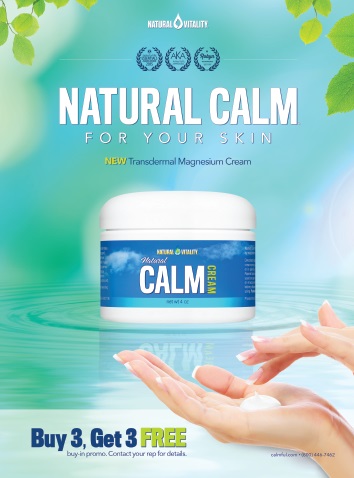
Given its structural importance, supplementation with collagen is a logical choice for joint maintenance. However, it will not reverse the course of cartilage damage already sustained. This is where early collagen supplementation can help. While many joint health products are marketed for middle aged and older consumers, the progressive damage of one’s joints begins long before then.
“It stands to reason that strategies that have been proven effective for improving joint comfort in older adult joints will have a similar effect for younger individuals,” says Suhail Ishaq, president, BioCell Technology, LLC, Newport Beach, CA. “Yet, few clinical studies have addressed efficacy in healthy individuals for collagen and related supplements…fewer still have involved younger adults as subjects.”
It might be valuable to target this neglected segment of customers since much of the pain experienced by older individuals is due to damage inflicted at a younger age. Young athletes often suffer injuries that they struggle with for the rest of their lives. Beginning supplementation may very well prolong a good quality of life that would allow for greater activity with age. Ishaq cites a study published in Integrative Medicine that tested the effects of cartilage extract (BioCell Collagen) on eight healthy and active people averaging 29 years of age.
Subjects were given 3 g of the extract or placebo daily for six weeks prior to being challenged with an upper body, muscle-damaging resistance exercise on day 43 and then rechallenged on day 46. Researchers measured the performance decrement in bench press repetitions to failure and found that the experimental group performed much better than placebo (57.9% on day 43 and 57.8% on day 46 vs. 72.2% on day 43 and 65% on day 46). While the sample size is small, the study suggests that collagen provides “robust muscular recovery” (1).
Paul Dijkstra, president and CEO of InterHealth Nutraceuticals, Benicia, CA, cites another study that demonstrates collagen’s efficacy for healthy, active individuals. In the randomized, double-blind, placebo-controlled study published by theJournal of the International Society for Sports Nutrition, 55 healthy subjects were either give an undenatured Type II collagen (UC-II) or placebo for 120 days. Their joint function was then tested for changes in degree of knee flexion and extension, as well as recovery time from joint pain following strenuous stepmill excursion (2).
Results showed that the experimental group had significant improvement in average knee extension compared to placebo and baseline scores after the 120 days and as early as 90 days into supplementation. They also exercised longer before experiencing joint discomfort after 120 days compared to baseline while the placebo group demonstrated no significant change in exercise length.
Glucosamine and chondroitin sulfate.Of course, collagen does not work alone. Glucosamine and chondroitin sulfate are also important building blocks of cartilage. As a precursor to glycosaminoglycans, which is necessary for the formation of proteoglycans, an important constituent of cartilage, glucosamine is important for the “synthesis and repair of joint cartilage,” says Holtby.
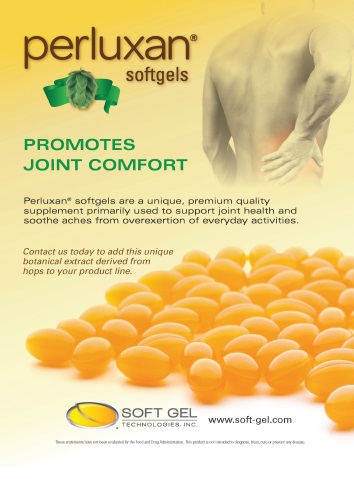 While glucosamine is a naturally occurring compound in our bodies, Susan Hazels Mitmesser, Ph.D., director, nutritional and scientific affairs at Solgar Vitamin and Herb, Leonia, NJ, points out that it is not readily found in our diets, making it an ideal candidate for supplementation.
While glucosamine is a naturally occurring compound in our bodies, Susan Hazels Mitmesser, Ph.D., director, nutritional and scientific affairs at Solgar Vitamin and Herb, Leonia, NJ, points out that it is not readily found in our diets, making it an ideal candidate for supplementation.Chondroitin sulfate is a glycosaminoglycan found in the proteoglycan of cartilage, therefore supported by glucosamine, making them a synergistic pair. Although it is worth noting that despite their being vital components of joint cartilage, in proportion to collagen and hyaluronic acid (HA), glucosamine and chondroitin make up a relatively small part of joint cartilage.
“If the product is helping you synthesize new connective tissue material in the joint cartilage,” says Ishaq, “a healthy joint requires the proper balance of collagen, HA, chondroitin and glucosamine in order to function.”
Mount concurs, saying, “Many people think of glucosamine first…but in reality it only makes up a very small percentage of cartilage tissue (15%) and should be thought of as a complementary nutrient to collagen type II, which accounts for the majority.” He adds that chondroitin (comprising 15% of cartilage) and HA (making up 10% of cartilage) work better as supporting nutrients, though an ideal formulation includes the proper ratio of all four nutrients.
HA.In addition to glucosamine, HA helps hydrate cartilage tissue to increase the shock absorption of joints. Chris D. Meletis, N.D., director of science and research for Trace Minerals Research, Ogden, UT, describes it as the difference between a plum and a prune. Well-hydrated joints are more resistant to injury, says Meletis, explaining that constituents of connective tissue such as HA “confer part of their protective mechanism via their ability to absorb and retain many times their weight in water.”
In addition, while combinations of glucosamine, chondroitin and MSM have become a go-to, the addition of HA is critical, says Meletis. This is because as we age, HA becomes less viscous, offering less shock absorption. “It is important to remind consumers that HA is a complex molecule comprised of glucosamine, but merely taking glucosamine does not ensure that the aging body can still optimally produce adequate high molecular weight HA,” he explains.
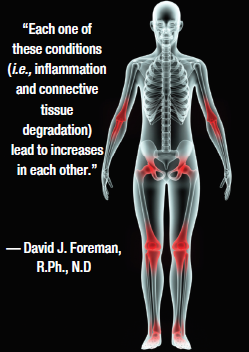
This is where the vicious cycle comes into play. “Each one of these conditions (i.e., inflammation and connective tissue degradation) lead to increases in each other,” explains David J. Foreman, R.Ph., N.D., author and host of the syndicated radio show, The Herbal Pharmacist. “The more inflammation you have, the more degrading of connective tissue occurs. This loss of connective tissue then leads to more inflammation and, in turn, more degrading of connective tissue.”
Additionally, joint problems and inflammation can occur for reasons other than injury, such as a poor diet and a sedentary lifestyle. In fact, a poor diet can exacerbate the body’s normal inflammatory response. Holtby attributes this to a “lopsided imbalance in dietary intake of the omega-6 and omega-3 fatty acids,” which “sets the stage for powerful and chronic pro-inflammatory reactions.”
Excess omega-6 is a problem because it acts as fuel to a key inflammatory enzyme cyclooxygenase-2 (COX-2), explains Holtby. The enzyme “has the job of oxidizing, or burning, a fat in the body called arachidonic acid...an omega-6 fatty acid” that “occurs naturally in all of our cell membranes,” he says. Put very simply by Holtby, omega-6 is the fuel, COX-2 is the spark and inflammation is the flame that results. This is not inherently bad, as inflammation is a natural mechanism of the body to defend and heal itself. However, too much fuel creates too much fire.
Omega-3. That is why omega-3 supplementation is important for supporting healthy inflammatory response. By offsetting the imbalance between omega-6 and omega-3 fatty acids, one would also be depleting the fuel that has created the chronic inflammation. Changes in overall diet would also calm the body’s overactive inflammatory response, particularly by reducing omega-6 consumption.
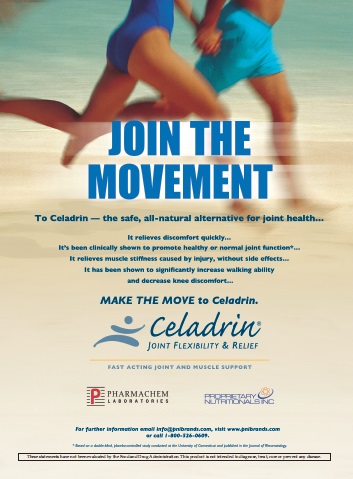
Supplementation will certainly help, but more sustained dietary changes will be far more effective. A basic example is using olive oil, particularly extra-virgin olive oil, rather than canola or other vegetable oils, which are high in pro-inflammatory fatty acids.
In addition to the overconsumption of omega-6s and underconsumption of omega-3s, Holtby says that a shortage of nutritional antioxidants also contributes to chronic inflammation. This is because certain pro-inflammatory cytokines can trigger the release of free radicals, which antioxidants neutralize.
Andrographis. Unlike OA, which is caused by the degradation of the cartilage in joints, Hame Persaud, executive vice president of HP Ingredients, Brandenton, FL, explains that rheumatoid arthritis (RA) results from the immune system mistakenly perceiving a threat and attacking healthy joints for a prolonged period, causing inflammation. “These individuals typically have high levels of c-reactive protein (CRP), a protein involved in acute and chronic inflammatory activity in unhealthy joints,” says Persaud, as well as rheumatoid factor, antibodies produced by the immune system that can attack healthy tissue, and tumor necrosis factor-alpha (TNF-alpha), a pro-inflammatory cytokine.
Research has shown thatAndrographis paniculataextracts are beneficial for supporting healthy joints, bones and muscles by controlling the body’s inflammatory response. Persaud describes a branded extract (Paractin) that has been standardized to andrographolide, 14-deoxyandrographolide and neoandrographolide—naturally occurring phytochemicals of the A. paniculata plant that have anti-inflammatory actions.
This extract, says Persaud, inhibits NF-kappaB activity, which is the “master switch” for inflammation, detecting threats and activating genes that produce inflammation. Inhibiting NF-kappaB thereby reduces pro-inflammatory cytokines and enzymes such as COX-2 that would have been activated. Andrographolide has also been shown to reduce TNF-alpha, in turn reducing rheumatoid factor.
In one randomized, double-blind, placebo-controlled study, published inClinical Rheumatology, 60 subjects were either given 100 mg of andrographolide or placebo thrice daily for 14 days, in conjunction with methotrexate (MTX), a common therapy for RA. Results showed that subjects who took both andrographolide and MTX saw a significant reduction in the number and total grade of swollen joints as well as the number and total grade of tender joints compared to placebo (3).
This improvement was associated with a reduction in rheumatoid factor, creatine kinase as well as IgA-RF and IgM-RF, two antibodies produced by the immune system to attack foreign bodies such as bacteria and fungus. The reduction of these antibodies is beneficial, says Persaud, because “there is a positive correlation with cartilage damage.”

One study in which seven healthy subjects were administered 200 mg of Pycnogenol for five days saw a 15% reduction in NF-kappaB compared to plasma drawn prior to treatment (4). This same study also found a 25% reduction in matrix metalloproteinase (MMP) enzymes. MMP enzymes, explains Carolina Burki-Sozzi, director of product development at Horphag Research, are responsible for the degeneration of cartilage collagen in osteoarthritis. This demonstrates an intersection between joint degeneration and inflammation.
Another study published inRedox Reportmeasured CRP and free radical levels in blood specimens of 55 subjects. After three months, the 29 subjects administered Pycnogenol saw a 72% reduction in CRP levels (3.9 mg/L to 1.1 mg/L vs. 3.9 mg/L to 3.6 mg/L in placebo) and a 30% reduction in free radicals, further supporting Pycnogenol’s anti-inflammatory activity as well as demonstrating its antioxidant activity (5).
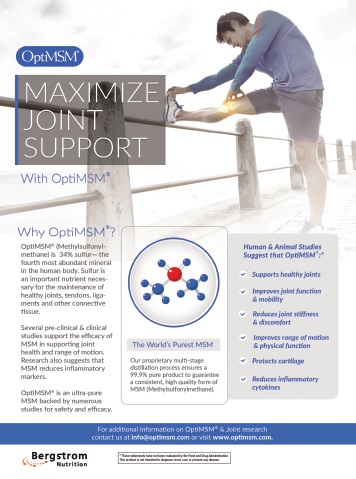 Research has also shown that people respond well to supplementation with Pycnogenol. A double-blind, placebo-controlled study published inPhytotherapy Research evaluated the efficacy of 100 mg of Pycnogenol in OA patients over a three-month period. Results showed a decrease of 56% in Western Ontario and McMaster Universities Arthritis Index (WOMAC) scores in the treatment group compared to a 9.6% decrease in the placebo group. Subjects taking Pycnogenol also showed a significant increase in the time spent walking during a treadmill test (from 68 minutes to 198 minutes versus 65 minutes to 88 minutes with placebo) (6).
Research has also shown that people respond well to supplementation with Pycnogenol. A double-blind, placebo-controlled study published inPhytotherapy Research evaluated the efficacy of 100 mg of Pycnogenol in OA patients over a three-month period. Results showed a decrease of 56% in Western Ontario and McMaster Universities Arthritis Index (WOMAC) scores in the treatment group compared to a 9.6% decrease in the placebo group. Subjects taking Pycnogenol also showed a significant increase in the time spent walking during a treadmill test (from 68 minutes to 198 minutes versus 65 minutes to 88 minutes with placebo) (6).MSM. Methylsulfonylmethane (MSM) is a naturally occurring nutrient derived from a variety of foods. While not found in joint tissue, MSM is 34% sulfur by weight, which is an important element in connective tissue, says Tim Hammond, vice president of marketing and sales for Bergstrom Nutrition, Vancouver, WA. By itself, MSM supports inflammatory response by reducing the expression of inflammatory cytokines such as TNF-alpha and interleukin-1, explains Rod Benjamin, director of technical development for Bergstrom Nutrition. However, MSM has a synergistic relationship with glucosamine because when inflammation is reduced, it facilitates the interaction between glucosamine and cartilage, says Benjamin.
Tart cherry. Montmorency cherry juice, says Jolie Root, senior nutritionist and educator for Carlson Laboratories, Arlington Heights, IL, is effective for easing post-workout soreness. “Tart cherries are considered to be one of the highest sources of phenolic compounds, including cyclooxygenase inhibitory flavenoids and anthocyanids,” says Root.
In one study, even after running a marathon, tart cherry juice helped ameliorate soreness. Fifty-four healthy runners taking part in a randomized, placebo-controlled, double-blind trial took either 355 mL of tart cherry juice or placebo twice daily. After seven days and competing in a long-distance relay, the treatment group experienced significantly less pain than the placebo group (7).
Rosehip.Rich in galactolipids, rosehip is a natural antioxidant that helps maintain healthy and
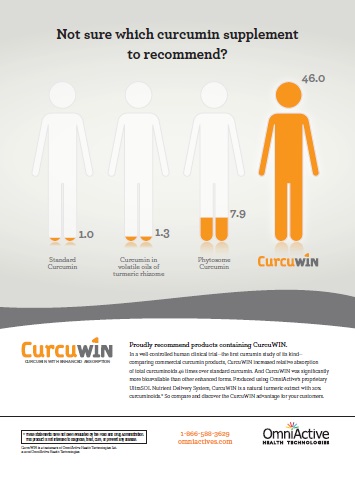 flexible joints by controlling inflammation. In a double-blind, randomized, placebo-controlled study, 100 subjects were either given 500 mg of rosehip powder or placebo twice daily for four months. After the four months, 64.6% of subjects in the treatment group experienced relief from their joint pain (8).
flexible joints by controlling inflammation. In a double-blind, randomized, placebo-controlled study, 100 subjects were either given 500 mg of rosehip powder or placebo twice daily for four months. After the four months, 64.6% of subjects in the treatment group experienced relief from their joint pain (8).“Laboratories studies have shown that GOPO [rosehip with galactolipids by Jakeman’s, Inc.] can switch off certain genes responsible for producing proteins and enzymes that have been implicated in inflammatory joint destruction,” says Jonathan Groves, president of Jakemans, Inc., Manchester, NH, adding that it can “switch on genes that help to produce collagen and cartilage.”
Esterified fatty acids.A proprietary blend of esterified fatty acids derived from bovine tallow oil (Celadrin) has been demonstrated to support inflammation in both oral and topical applications. In a double-blind, multi-center, placebo-controlled study published in theJournal of Rheumatology, 64 subjects with chronic knee OA were either given esterified fatty acids or placebo for 68 days. During this time, knee function was evaluated at baseline, 30 days and 68 days (7).
Results showed that subjects in the treatment group experienced significant improvement in knee flexion and improved scores on the Lequesne Algofunctional Index, which assesses pain and discomfort, walking distance and physical function. Fifty-eight percent of the treatment group experienced a reduction of pain compared to 32% of the placebo group. While improvements of swelling were minimal in the treatment group, with 15% of subjects seeing reduction in swelling, none of the placebo group saw a reduction (9).
Another double-blind, placebo-controlled study measured the effect of esterified fatty acids in a topical cream on the range of motion in knees of OA patients. Given either esterified fatty acids or placebo, subjects were evaluated at baseline, 30 minutes after application and 30 days after applying the cream twice daily. The experimental group saw a significant improvement on tests both 30 minutes and 30 days after beginning the trial. Authors concluded that esterified fatty acids applied topically were “effective for improving knee range of motion; improving ability to climb stairs, rise from a chair, and walk; and improving balance, strength, and endurance in patients with knee OA” (10).
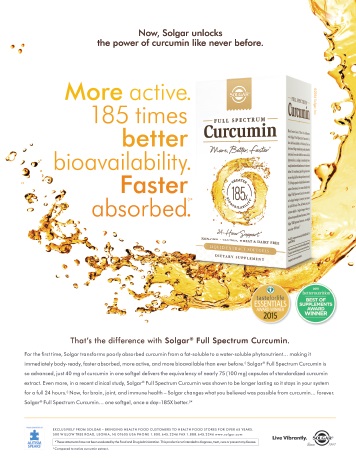 Dean Mosca, president, Proprietary Nutritionals Inc., Kearny, NJ, says that the esterified fatty acids in his company’s formula affect the inflammatory response by reducing the production of interleukin-6, inhibiting endothelial cells as well as inhibiting arachidonic acid—discussed previously as a pro-inflammatory omega-6 fatty acid—by inhibiting 5-lipoxygenase.
Dean Mosca, president, Proprietary Nutritionals Inc., Kearny, NJ, says that the esterified fatty acids in his company’s formula affect the inflammatory response by reducing the production of interleukin-6, inhibiting endothelial cells as well as inhibiting arachidonic acid—discussed previously as a pro-inflammatory omega-6 fatty acid—by inhibiting 5-lipoxygenase.Magnesium.An important mineral for bone health, magnesium is making its way into joint health sector as well. Natural Vitality is releasing a topical magnesium (Natural Calm Cream), says Andreas Koch, vice president of marketing for the Austin, TX-based firm. Applying this product directly to areas experiencing discomfort, says Koch, will ease muscle tension, pain and inflammation. Consuming larger amounts of supplemental magnesium has been associated with lower CRP levels, says Caroline Dean, M.D., N.D., Medical Advisory Board Member of the Nutritional Magnesium Association.
“A greater risk of having an elevated CRP level of over 3 mg/L by 49% was found among participants whose magnesium intake was lowest in comparison with the highest intake group,” says Dean, citing a meta-analysis of cross-sectional studies involving 32,918 subjects (11). As a transdermal application, magnesium has already been shown to ease symptoms and improve quality of life in subjects with fibromyalgia (12). Used locally at the joints, magnesium has the potential to not only ease joint inflammation but also soothe aching muscles surrounding the joint.
Protein complex. Some ingredients support joint health through multiple pathways. James J. Scaffidi, DNMc, BSc, CEO and president of Zycal Bioceutical Healthcare Co., Inc., Toms River, NJ, says that a protein complex derived from organic bovine and manufactured by his firm (Cyplexinol), “works by turning on the stem cell in the joint to become new, healthy chondrocites, which absorb glucosamine, chondroitin molecules and create new cartilage known as proteoglycans.”
Because of this, the protein complex works synergistically with glucosamine and chondroitin supplements, but Zycal also provides a product that incorporates all three ingredients together. In addition to its capacity in supporting the composition of the joints, this protein complex also regulates inflammatory response. Scaffidi says that it regulates inflammation at a higher level than other ingredients by inhibiting interleukins. “Interleukin-1 and interleukin-6 down regulate both NF-kappaB and MMP,” he explains. “So we’re really getting to the top of the food chain for inflammatory signaling.”
In a randomized, double-blind, placebo-controlled study published inIntegrative Medicine, 87
|
Select Joint Health Products Bergstrom Nutrition: OptiMSM.Carlson Laboratories: Carlson Tart Cherry, Nutra Support Joint; Norwegian Cod Liver Oil. CV Sciences: PlusCBD Oil Capsules, PlusCBD Oil Total Plant Complex Grams, PlusCBD Oil Gold Formula Grams, PlusCBD Oil Total Plant Complex Oral Applicators, PlusCBD Oil Gold Formula Oral Applicators Endoca: Hemp Oil Drops 300 mg CBD, RAW Hemp Oil Drops 300 mg CBD+CBDa, Hemp Oil Drops 1500 mg CBD, RAW Hemp Oil Drops 1500 mg CBD+CBDa, Capsules Hemp Oil 300 mg CBD, Capsules Raw Hemp Oil 300 mg CBD+CBDa, Capsules Hemp Oil 1500 mg CBD, Raw Capsules Hemp Oil 1500 mg CBD+CBDa, Raw Hemp Oil 2000 mg CBD+CBDa, Raw Hemp Oil 2000 mg CBD, Raw Hemp Oil 3000 mg CBD+CBDa. Gelita: FORTIGEL Bioactive Collagen Peptides. Horphag Research: Pycnogenol. HP Ingredients: ParActin InterHealth Nutraceutical Inc.: UC-II. Jakeman’s Inc.: GOPO Rosehip with Galactolipids, 120 ct, GOPO Rosehip with Galactolipids, 200 ct NeoCell: Collagen2 Joint Complex, Move Matrix Advanced Joint Hydrator, Joint Bursts Soft Chews, Hyaluronic Acid Double Strength, Blueberry Hyaluronic Acid Liquid. Proprietary Nutritionals, Inc./ Pharmachem Laboratories: Celadrin Sabinsa: Curcumin C3 Complex, Boswellin, Boswellin PS, Polysal/ PolyBos, Ginger extract, ArthriCare SR, Nilitis SR, Boswellin and Curcumin Complex, Bone Health, Joint Health and R3 Joint. Soft Gel Technologies, Inc.: Perluxan, Injuv (HA complex) with Glucosamine, Vitamin D, EZ Mega 3, Cod Liver Oil, CoQsol, CoQsol-CF and CoQH-CF. Solgar Vitamin and Herb: Solgar No. 7 Vegetable Capsules, Glucosamine Hyaluronic Acid Chondroitin MSM (Shellfish-Free) Tablets, Extra Strength Glucosamine Chondroitin MSM with Ester-C Tablets, Triple Strength Glucosamine Chondroitin MSM (Shellfish-Free) Tablets, Extra Strength Glucosamine Chondroitin Complex Tablets. Trace Minerals Research: ActivJoint packets, ActivJoint tablets (vegan), ActivJoint Platinum tablets, Liquid ActivJoint Platinum, Glucosamine/Chondroitin/MSM tablets, Liquid Glucosamine/Chondroitin/MSM, Liquid Glucosamine/MSM. Zycal Bioceuticals Inc.: Ostinol Standard 150, Ostinol Standard 350, Ostinol Standard 450, Ostinol Standard 700, Ostinol Standard 900, Ostinol Insta Joint Relief, Chondrinol, Pro-Vive Immunity Activator 2X. |
|
Cannabidiol. While controversial, given the stigma of marijuana, it’s important to examine cannabis’s utility and how you can sell it at retail. Cannabidiol (CBD), a cannabinoid extracted from hemp (Cannabis Sativa L.), is the second most prominent compound in cannabis, of which there are over 80, the most well-known of which, is THC, explains Marco Cappiello, COO of Endoca, Los Angeles, CA.
Unlike THC, however, CBD is not psychoactive, meaning there is no psychoactive effects that result from consuming CBD. It is also unlike hemp oil, which while nutritious as a source of essential fatty acids, is not highly concentrated enough to be a reliable source of phytocannabinoids. With regard to joint health, CBD supports a healthy inflammatory response. While still in its infancy, emerging research suggests that conditions such as OA can be associated with clinical endocannabinoid deficiency (CECD), given the therapeutic benefits of cannabis (14).
While human clinical data is limited, animal studies on mice exist. In a recent review of research on the therapeutic use of cannabinoids, the authors stated, “The ubiquitous distribution of cannabinoid receptors, together with the physiological role of the endocannabinoid system in the regulation of pain, inflammation and even joint function further support the therapeutic interest of cannabinoids for OA” (15).
The endocannabinoid system, explains Hector Lopez, M.D., scientific and medical advisor to CV Sciences, Las Vegas, NV, is a complex physiological network comprised of cannabinoid receptors (CB1 and CB2), endogenous cannabinoid compounds such as anandamide and 2-AG, and their respective enzymes, which regulate the synthesis and breakdown to endocannabinoid compounds. “Not surprisingly, cannabinoid receptors and the biochemical machinery necessary to synthesize and generate cannabinoids are important in regulating a wide range of functions across every major organ system in the body,” says Lopez. This includes the musculoskeletal system.
CECD associated with OA, says Cappiello, “is both genetic and acquired, affecting CB2 receptors in the musculoskeletal system.” Supplementation with CBD, he continues, “is suggested to support the inflammatory response throughout the musculoskeletal system, and increase anandamide production which enhances cannabinoid binding to CB2 receptors.”
Lopez also emphasizes the importance of CB2 receptors. He explains that in animal studies and human cartilage cell cultures, there was substantial improvement when CB2 receptors were preferentially stimulated. This is particularly promising because CBD, explains Lopez, “appears to favor a CB2 receptor tone over CB1 receptor, and as such, appears to be well suited for the role of augmenting joint health, mobility and joint/muscle/tendon discomfort associated with day-to-day physical overexertion or exercise.”
Curcumin.This is certainly a familiar ingredient, garnering a great deal of attention for supporting inflammatory response throughout the body. No doubt, your shelves are stocked with a number of curcumin formulas targeting aspects of health ranging from cognitive well being to lower back pain. Shaheen Majeed, marketing director at Sabinsa, East Windsor, NJ, describe
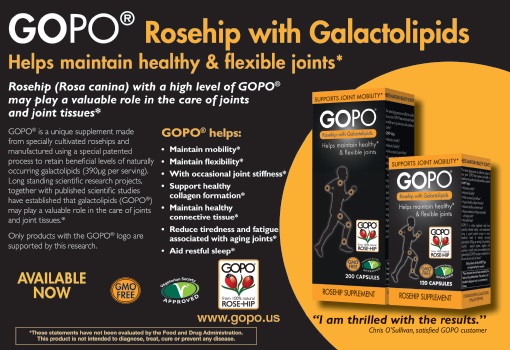 s curcumin as “an effective ‘Bioprotectant,’ quenching free radicals and preventing their formations,” as well as helping to “reduce pain and inflammation by inhibiting NF-kappaB.”
s curcumin as “an effective ‘Bioprotectant,’ quenching free radicals and preventing their formations,” as well as helping to “reduce pain and inflammation by inhibiting NF-kappaB.”However, as with all ingredients, not all curcumin supplements are created equal. Generally speaking, curcumin has poor bioavailability, but supplement manufacturers have developed a variety of ways to address this problem and optimize the ingredient’s effectiveness, which research has supported. One randomized, double-blind, placebo-controlled study tested the efficacy of 1,500 mg of curcumin daily on subjects with mild-to-moderate OA versus placebo. Utilizing a specific formulation of curcuminoids (Curcumin C3 Complex by Sabinsa), researchers found that scores on health surveys, the WOMAC in particular, improved significantly, with subjects experiencing a reduction of pain and improved function (16).WF
References

1. H.L. Lopezet al. “Evaluation of the Effects of BioCell Collagen, a Novel Cartilage Extract, on Connective Tissue Support and Functional Recovery From Exercise.”Integrative Medicine. 14(3): 30-38. 2015. 2. J.P Lugoet al.“Undenatured type II collagen (UC-II®) for joint support: a randomized, double-blind, placebo-controlled study in healthy volunteers.”J Int Soc Sports Nutr. 10:48. 2013. 3. M. Hidalgoet al. “Efficacy of an Andrographis paniculata composition for the relief of rheumatoid arthritis symptoms: a prospective randomized placebo-controlled trial.”Clinical Rheumatology.4. T. Grimmet al. “Inhibition of NF-κB activation and MMP-9 secretion by plasma of human volunteers after ingestion of maritime pine bark extract (Pycnogenol).”J Inflamm.3: 1. 2006. 5. G. Belcaroet al.“Variations in C-reactive protein, plasma free radicals and fibrinogen values in patients with osteoarthritis treated with Pycnogenol.”Redox Report. 13(6): 271-276. 2008. 6. G. Belcaroet al.“Treatment of osteoarthritis with Pycnogenol. The SVOS (San Valentino Osteo-arthrosis Study). Evaluation of signs, symptoms, physical performance and vascular aspects.”Phytotherapy Research. 22(4): 518-513. 2008. 7. K.S. Kuehlet al."Efficacy of tart cherry juice in reducing muscle pain during running: a randomized controlled trial."J Int Soc Sports Nutr. May 7(7). 2010. 8. O. Warholmet al."The Effects of a Standardized Herbal Remedy Made from a Subtype ofRose caninain Patients with Osteoarthritis: A Double-Blind, Randomized, Placebo-Controlled Clinical Trial."Current Therapeutic Research. 64(1). 2003. 9. R. Hesslinket al. "Cetylated Fatty Acids Improve Knee Function in Patients with Osteoarthritis."J Rheumatol. 29: 1708-1712. 2002. 10. W.J. Kraemeret al."Effect of a Cetylated Fatty Acid Topical Cream on Functional Mobility and Quality of Life of Patients with Osteoarthritis."J Rheumatol. 31: 767-774. 2004. 11. D.T. Dibaba,et al.“Dietary Magnesium Intake is Inversely Associated with Serum C-reactive Protein Levels: Meta-analysis and Systematic Review.”Eur J Clin Nutr. 68(4): 510-516. 2014. 12. D.J. Engen,et al. “Effects of transdermal magnesium chloride on quality of life for patients with fibromyalgia: a feasibility study.”J Integr Med. 13(5): 306-313. 2015. 13. R. Garian and J. Scaffidi. “Evaluating Clinical Response and Activity of Cyplexinol Osteoinductive Proteins in Osteoarthritis of the Hip and Knee: A Randomized, Controlled Trial.”Integrative Medicine. 12(2): 18-24. 2013. 14. S.E. Smith and M.S. Wagner. ”Clinical endocannabinoid deficiency (CECD) revisited: Can this concept explain the therapeutic benefits of cannabis in migraine, fibromyalgia, irritable bowel syndrome and other treatment-resistant conditions?”Neuroendocrinology Letters. 35(3): 198-201. 2014. 15. C. La Portaet al. “Involvement of the endocannabinoid system in osteoarthritis pain.”Eur J Neurosci. 39(3): 485-500. 2014. 16. Y. Panahiet al.“Curcuminoid treatment for knee osteoarthritis: a randomized double-blind placebo-controlled trial.”Phytotherapy Research.28(11): 1625-1631. 2014.
Published in WholeFoods Magazine June 2016










